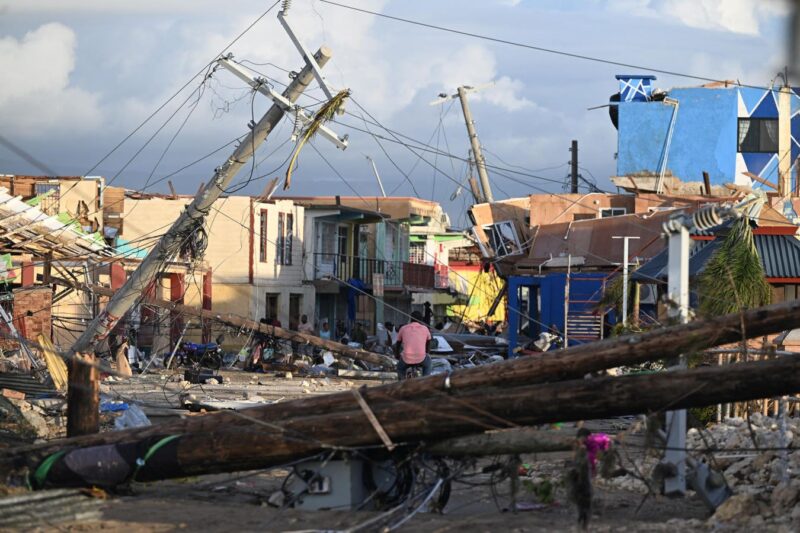Maya Angelou once penned words that thunder across generations—a defiant proclamation that no matter how deeply we are pressed into the earth, no matter the weight of history or circumstance bearing down upon us, the human spirit possesses an unyielding determination to rise. Beyond poetic optimism, this is the lived reality of survival against impossible odds – odds that faced Jamaica when Hurricane Melissa made landfall on its northern coast with sustained winds exceeding 150 miles per hour. Beyond testing the infrastructure of this resilient island-nation, it exposed the precise fault lines where 21st-century climate realities collide with 20th-century systems, revealing truths about vulnerability, resilience, and the future of healthcare that the world can no longer afford to ignore.
TOPSHOT – Electrical poles are down as a man bikes through the destroyed neighborood of North Street following the passage of Hurricane Melissa, in Black River, Jamaica on October 29, 2025.
AFP via Getty Images
A Storm Beyond Our Designs
When Category 5 Melissa finally made landfall after circling Jamaica like a predator studying its prey, foreshadowing gave way to fury. For hours, it hammered the island with unprecedented intensity; a violence that bore little resemblance to the hurricanes encoded in institutional memory or engineering manuals. Power grids collapsed within hours, plunging entire parishes into darkness, and communication towers toppled like dominoes, severing the digital lifelines that connect us to help, to information, and to each another.
The western parishes bore the brunt of Melissa’s wrath—communities like Negril, Savanna-la-Mar, and Lucea faced devastation so complete that responders – yet, survivors – struggled to find words adequate to the scene. Entire neighborhoods were stripped to their skeletal frames, belongings scattered across mud-choked streets, family photographs drowning in debris. Children’s toys hung from power lines. Refrigerators lay overturned in roads. The markers of ordinary life, kitchen tables, wedding albums, medication bottles, became rubble. And amongst that rubble were soon to be found – human beings who drew breath only hours before.
Jamaica would emerge from this maelstrom to find roofs torn from 80–90% of homes in affected regions, with entire neighborhoods stripped to their skeletal frames. This wasn’t merely natural disaster; it was cascading systems failure, revealing how our modern infrastructure functions like a house of cards when nature decides to blow.
A satellite view shows Hurricane Melissa approaching Jamaica as the sun rises near New Hope
Anadolu via Getty Images
When Hospitals Become Casualties
In those hours, it became impossible to separate climate from care. Five hospitals across the island sustained significant damage, their vulnerabilities laid bare not through negligence but through the harsh arithmetic of competing priorities in resource-constrained settings. Like many emerging economies navigating the perpetual tension between immediate needs and long-term preparedness, Jamaica’s healthcare infrastructure reflects decades of difficult choices—investments deferred, maintenance postponed, upgrades delayed in favor of more pressing demands.
The loss of talented clinicians to opportunities abroad had already stretched thin the expertise available to navigate crises, and now those who remained found themselves fighting a war on terrain for which no training manual existed: caring for the critically ill in complete darkness, delivering babies by flashlight, keeping dialysis patients alive without power, watching helplessly as floodwaters transformed hospital basements into rivers, destroying medication stockpiles, medical records, and the very equipment that stands between life and death. When the power died, refrigeration failed. When refrigeration failed, vaccines spoiled and insulin degraded. Jamaica became what disaster researchers call a “living laboratory” for compound crises: the dangerous intersection where climate extremes meet healthcare capacity, digital dependency, and supply chain brittleness. This is what the climate-health nexus looks like in practice: a lived reality where meteorological violence translates directly into medical crisis, and the same storm that tore roofs also severed the lifelines that keep chronic disease patients alive.
The Economics of Survival: Can We Truly Build Resilience Into Healthcare?
Early economic-loss estimates sit in a sobering band—US$5–15 billion across the region—and while Jamaica’s catastrophe bond will pay out for the first time, money cannot restore what was lost or unsee what was witnessed. Families grieved confirmed deaths even as they tried to find relatives and refill prescriptions. Yet amid the devastation, a question emerged: was this catastrophe inevitable, or the predictable outcome of systems designed for a climate that no longer exists?
TOPSHOT – An aerial view of destroyed buildings following the passage of Hurricane Melissa, in Black River, St. Elizabeth, Jamaica on October 29, 2025.
AFP via Getty Images
The traditional approach treats healthcare resilience as charitable relief—something addressed with aid after crises hit. Melissa’s experience suggests this framework is both economically irrational and morally insufficient. Had $50 million been invested in resilient backup power, distributed supply chains, and fortified facilities beforehand, the return wouldn’t be measured in basis points—it would be measured in lives saved and economies stabilized.
Health Minister Dr. Christopher Tufton’s rapid mobilization of field hospitals across five western parishes and coordination with the Jamaica Defence Force demonstrated decisive crisis leadership, while Prime Minister Andrew Holness’s disaster risk financing framework provided the institutional backbone for response. At the University Hospital of the West Indies, Medical Chief of Staff Dr. Carl Bruce—whose experience leading through COVID-19 had already tested healthcare system endurance—coordinated efforts to maintain critical services as power grids collapsed and supply chains fractured.
Yet a deeper question persists: should small island states bear these costs alone? As Barbados Prime Minister Mia Mottley has powerfully argued, there is a profound asymmetry at work—those whose histories helped fuel industrialization now face disproportionate costs from its climate consequences. For Jamaica and its Caribbean neighbors, this isn’t abstract economics; it’s existential mathematics. The path forward requires not charity but partnership, not sympathy but solidarity in rebuilding systems designed for the climate we have, not the one we remember.
TOPSHOT – A man uses his cellphone at the waterfront in Kingston on October 27, 2025. Hurricane Melissa threatened Jamaica with potentially deadly rains after rapidly intensifying into a top-level Category 5 storm
AFP via Getty Images
Rising From The Rubble
Hurricane Melissa will fade from news cycles, as disasters inevitably do. But the lessons being etched into Jamaica during these weeks of recovery must ripple outward into policy, practice, and preparation, carrying truths that transcend geography.
In the wreckage of collapsed hospitals and flooded clinics, Jamaica has the opportunity to draft something invaluable: a manual for healthcare resilience in an era of climate disruption. It will be written in the improvised solutions now being deployed—distributed data systems, mobile pharmacies, solar-powered equipment—and in the recognition that climate change demands fundamentally different approaches to care delivery. Small island states stand on the frontlines of climate disruption not by choice but by circumstance, yet that vulnerability can forge a laboratory for adaptation that the entire world will eventually need.
When the next Melissa arrives—and it will, whether in Kingston or Manila, Miami or Mumbai—we will face a choice. We can treat it as an anomaly, or recognize it for what Jamaica is teaching us: the new baseline, the conditions under which 21st-century healthcare must learn to function.
Maya Angelou’s words echo still: we rise. But rising is not inevitable—it is intentional. It requires investment before crisis, partnership over paternalism, and the courage to reimagine systems that no longer serve the world we inhabit. In Melissa’s wake, Jamaica is choosing not merely to rebuild what was, but to reimagine what must be. The transformation from storm to solidarity is not yet complete—but it has begun. The question is whether the rest of us possess the wisdom to learn from those navigating this crisis in real time, and the humility to follow where Jamaica is leading.
The human spirit’s determination to rise, as Angelou promised, remains unyielding. But it cannot rise alone.









